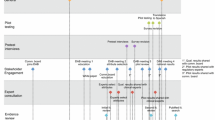Abstract
Background: During the 1990s, there was a rapid increase in sales of Natural Health Products (NHPs) on the Canadian market. In 1997, the Canadian government put forth a proposal for increased regulation of NHPs. The new regulations were intended to address a number of consumer issues: a lack of adequate product information and poor product quality. This regulatory climate provided a unique opportunity to ascribe monetary values to the new regulations using contingent valuation willingness-to-pay (WTP) methods.
Objectives: To determine: (i) if NHP consumers use these products together with or instead of conventional medications; (ii) consumers’ WTP for increased regulation of NHPs; and (iii) consumers’ responsiveness to risk and how it affects their choice of treatment.
Methods: Investigators used a subject-administered interactive computer survey to query a convenience sample of 306 Canadian consumers. Three hypothetical symptom/disease scenarios (cough and cold, arthritis, high blood pressure) with NHP treatment choices of increasing risk of harm were posed. Information on consumers’ WTP, regulatory preferences, and responses to increasing gradients of treatment risk were collected. For each scenario respondents chose one of three labels (proxies for regulation preference), ranked the importance of regulatory (safety, product quality) and nonregulatory (cost) NHP attributes and indicated their WTP for these attributes.
Results: The survey respondents were most commonly white and female (58.8%), between 35–40 years old (36.6%), married (55.2%), better educated, i.e. with some college education (29.7%), with a household income above 60 000 Canadian dollars (28.4%) and in good health (36.9%). The most likely NHP purchase site was a pharmacy (55.6%). Complementing or substituting for conventional medication was dependent on the scenario; as the risk profile of the scenario increased, the majority of respondents changed their treatment to more conventional therapy. ‘Substituters’ decreased from 23.5% in the first (least risky) scenario to 11.1 % in the last, most risky scenario. WTP for increased regulation was 90% over the NHP’s base price. Consumers were most willing to pay for information on quality, followed by side effects, drug interactions and efficacy; the majority (75%) chose the label that provided the most information.
Conclusions: Respondents demonstrated risk aversion to the purchasing of NHPs by choosing conventional medicines over NHPs as the risk of harm increased by scenario and choice of treatment. Most respondents were willing to pay almost double the current NHP base price for the increased safety and information promised by the new regulations (demonstrated in this project by more informative NHP product labels).









Similar content being viewed by others
References
Newslinks. Industry sales surge, but may settle in new century. Whole Foods 1999 Feb: 14–5
Eisenberg DM, Davis RB, Ettner SL, et al. Trends in alternative medicine use in the United States, 1990–1997, results of a follow-up national survey. JAMA 1998 Nov 11; 280(18): 1569–75
Ernst E. Complementary medicine: common misconceptions. J R Soc Med 1995; 88: 244–7
Health Canada. The Canadian Food and Drugs Act: consolidation of the Food and Drugs Act and the Food and Drug Regulations [online]. Available from URL: http://www.hc-sc.gc.ca/food-aliment/friia-raaii/food_drugs-aliments_drogues/act-loi/e_index.html [Accessed 2003 Aug 11]
Health Canada. Drugs directorate guideline: guidelines for traditional herbal medicines (revised). Ottawa (ON): Therapeutic Drugs Directorate, 1995
Health Canada. Policy issues: from the Drugs Directorate Bureau of nonprescription drugs — medicinal herbs in traditional herbal medicines. Otawa (ON): Health Canada, 1995
The Canadian Health Food Association. The regulation of natural health products in Canada: the impact of inappropriate regulations [information brochure]. Mrkham (ON): Canadian Health Food Association, 1998
Health Canada. Health Canada to establish an advisory panel on herbal remedies. Otawa (ON): Health Canada, 1997: 34
Volpe J. Chair, natural health products: a new vision. Report of the Standing Committee on Health. Otawa (ON): Health Canada, 1998: 91–95 [online]. Available from URL: http://www.parl.gc.ca/InfoComDoc/36/1/HEAL/Studies/Reports/healrp02-e.htm [Accessed 2003 Aug 22]
Health Canada. Regulatory impact analysis statement [online]. Available from URL: http://www.hc-sc.gc.ca/hpb/onhp/rias_doc3_e. [Accessed 2002 Jul 24]
Glanz K, Lewis FM, Rimer BK, editors. Health behavior and health education: theory, research, and practice. 2nd ed. Sn Francisco (CA): Jossey-Bass, 1997: 63–91
Carter WB. Psychology and decision making: modelling health behavior with multiattribute utility theory. J Dent Educ 1992; 56(12): 800–7
Sayeki Y. Allocation of importance: an axiom system. J Math Psychol 1972; 9: 55–65
Eisenberg DM, Kessler RC, Foster C, et al. Unconventional medicine in the United States. Prevalence, costs, and patterns of use. N Engl J Med 1993; 328(4): 246–52
Druss BG, Rosenheck RA. Association between use of unconventional therapies and conventional medical services. JAMA 1999; 282(7): 651–6
Bouldin AS, Smith MC, Banahan BF, et al. Herbal supplement information for the consumer. Drug Inf J 2000; 34: 1339–53
Bilodeau BA, Degner LF. Information needs: sources of information and decisional roles in women with breast cancer. Oncol Nurs Forum 1996; 23(4): 691–6
Llewellyn-Thomas H, Sutherland HJ, Tibshirani R, et al. The measurement of patient values in medicine. Med Decis Making 1982; 2: 450
Acknowledgements
This project would not have been possible without the funding received by the Burroughs Wellcome Fund and the American Foundation for Pharmaceutical Education under the auspices of the American Association of Colleges of Pharmacy New Investigators Program for Pharmacy Faculty. The authors have no conflicts of interest that are directly relevant to the content of this manuscript.
Author information
Authors and Affiliations
Corresponding author
Rights and permissions
About this article
Cite this article
Norrie, O., Metge, C.J. Determining Consumer Willingness to Pay, Risk Behavior and Preferences. Pharm Dev Regul 1, 205–213 (2003). https://doi.org/10.1007/BF03257379
Published:
Issue Date:
DOI: https://doi.org/10.1007/BF03257379




